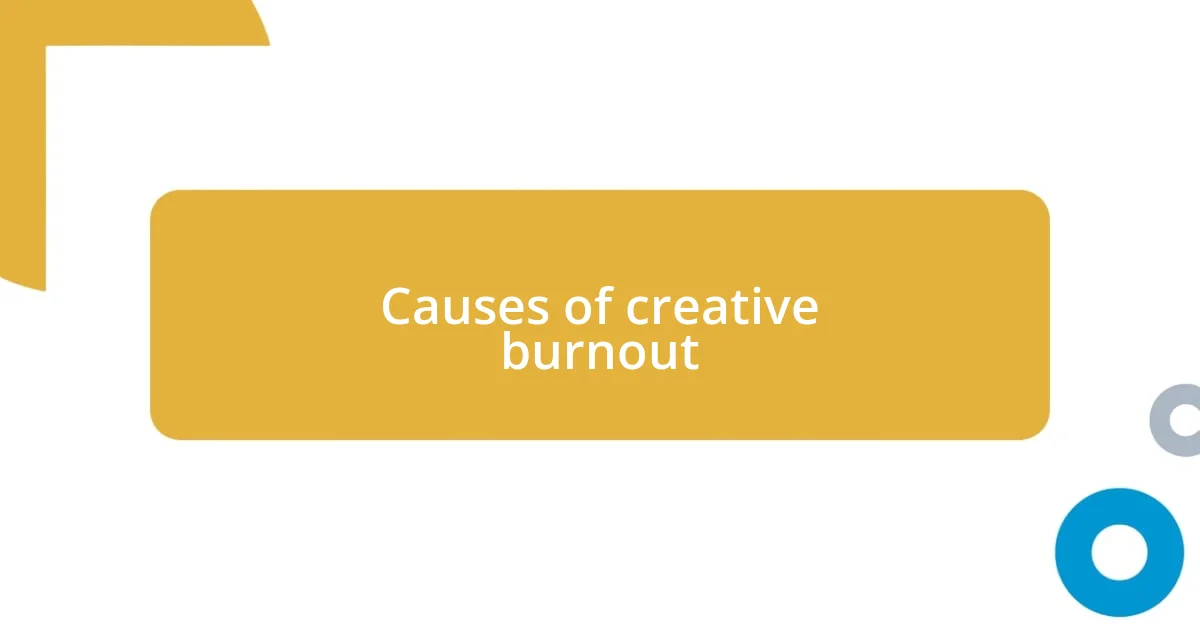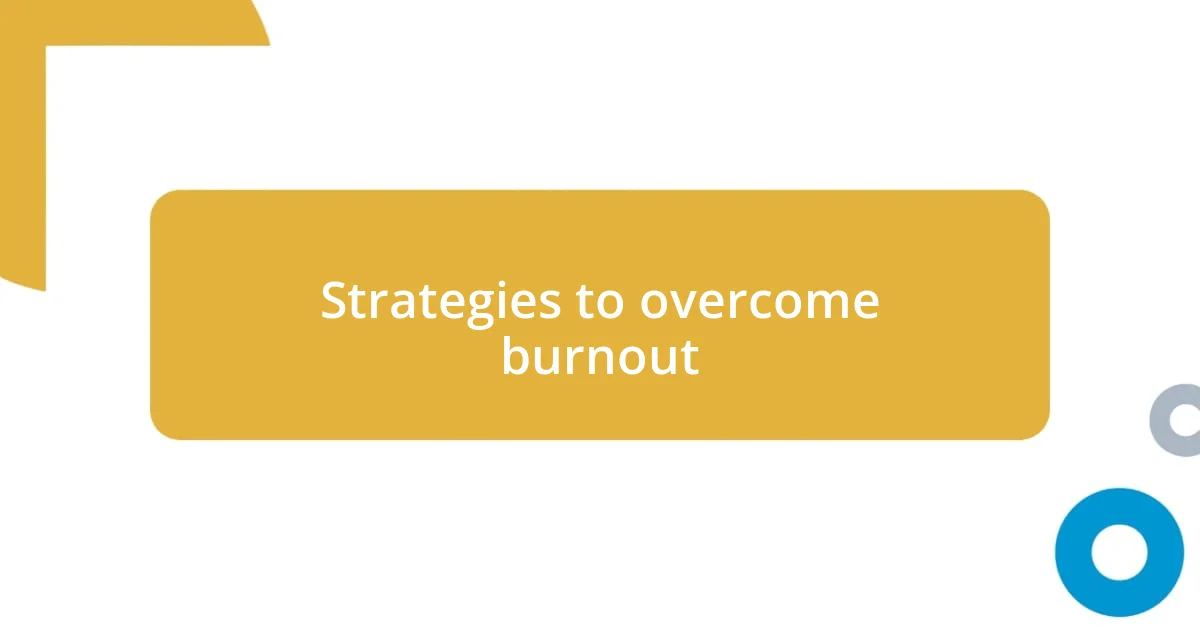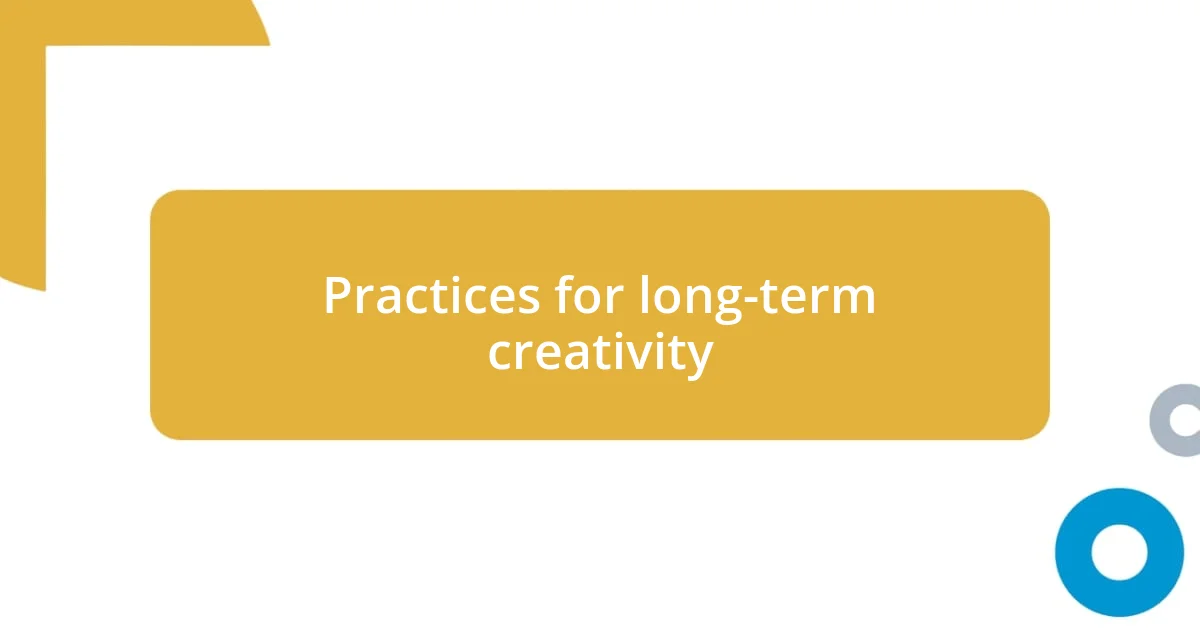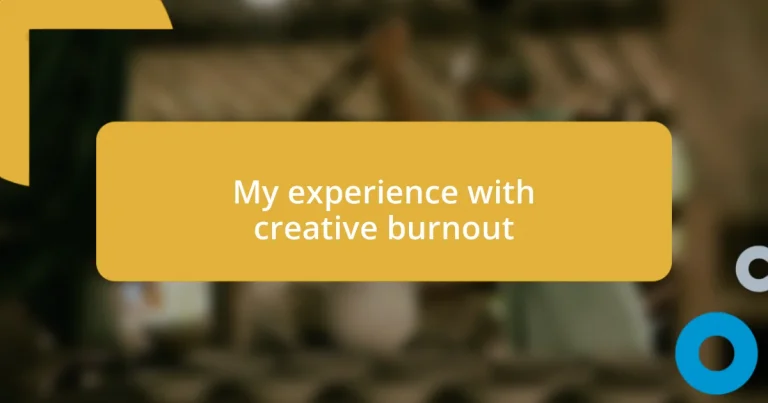Key takeaways:
- Creative burnout is characterized by exhaustion, lack of motivation, emotional fatigue, and a loss of inspiration, often exacerbated by self-imposed pressure and isolation.
- To overcome burnout, it’s essential to prioritize breaks, embrace playfulness in creativity, and connect with fellow artists for support and inspiration.
- Preventing future burnout involves intentional practices such as setting healthy boundaries, nurturing curiosity through new interests, and allowing downtime for creativity to flourish.

Understanding creative burnout
Creative burnout is more than just feeling tired; it’s a profound sense of exhaustion that can sap your passion and inspiration. I vividly recall a time when I sat in front of a blank page, knowing I had deadlines looming, yet feeling completely drained of ideas. Why does this happen? For me, it was the relentless pressure to produce that overshadowed my natural creativity.
There are moments when I felt completely detached from my work, as if I was merely going through the motions. In those instances, I found myself questioning the very essence of my art. What was it that initially fueled my creativity? Reflecting on this emptiness made me realize I needed space to reset and rediscover what truly motivated me.
The realization hit me hard: burning the candle at both ends only extinguishes your creative spark. I’ve learned the hard way that creativity thrives in a nurturing environment, not a pressured one. So, when you find yourself in that dark place of burnout, it’s crucial to step back and give yourself permission to breathe and recharge—after all, our creativity deserves that care.

Signs of creative burnout
Recognizing the signals of creative burnout is crucial for any artist. One sign I’ve experienced is a persistent lack of motivation. I remember days when even the most exciting projects felt like tedious chores, leaving me questioning why I ever loved creating in the first place. If you find yourself dreading the canvas or keyboard, it’s a clear flag that your creativity might be running on empty.
Another indicator that I’ve often overlooked is emotional exhaustion. This isn’t just about feeling tired; it’s that deep-seated sense of being drained. There were times when I found myself unusually irritable or emotional about feedback. I would feel like my whole identity as a creator was in jeopardy, simply because my emotional reservoir had been depleted. If your passion projects start feeling more like burdens, it’s essential to pay attention to that feeling.
Lastly, losing the spark of inspiration is a significant warning sign. I can recall moments when I would stare blankly at my work, yearning for an idea that wouldn’t come. Every creative person encounters dry spells, but if these clouds loom persistently, it’s a sign to reassess your mental wellness. Are you allowing yourself to explore new experiences? When was the last time you stepped away from your routine? Exploring external avenues can kick-start your motivation and rejuvenate your creative spirit.
| Sign | Description |
|---|---|
| Lack of Motivation | Projects begin to feel tedious, leading to a loss of enjoyment in creating. |
| Emotional Exhaustion | Feelings of irritability or emotional detachment from one’s work, indicating deeper fatigue. |
| Loss of Inspiration | Struggling to come up with ideas, often causing a prolonged creative block. |

Causes of creative burnout
I’ve noticed that one of the main causes of creative burnout is the overwhelming pressure we place on ourselves to deliver. In the early days of my creative journey, I often felt like I was in a race against time. Each deadline loomed larger than life, and I’d push myself beyond limits that I wish I’d respected more. This constant self-imposed pressure not only stifled my creativity but also clouded the joy I once felt in creating. The ironic part? The harder I tried to force inspiration, the more morose and uninspired my work became.
Another significant factor that I’ve experienced is the lack of balance in life. There were phases when I got so consumed by projects that I neglected everything else—socializing, exercising, even just soaking up fresh air. This created an emotional and physical drain that seemed to seep into my creative work. It took time for me to recognize the correlation between self-care and creativity. Here are some customary culprits that can lead to creative burnout:
- Overcommitment: Taking on too many projects can stretch your mental bandwidth thin, leaving little room for genuine inspiration.
- Monotony: Doing the same type of work day in and day out can stifle creativity, making it feel more like a job and less like a passion.
- Perfectionism: Striving for unattainably high standards can lead to a fear of failure and block the flow of ideas.
- Isolation: Without feedback or collaboration, creativity can feel like a lonely pursuit, which can exacerbate feelings of burnout.
- Inadequate Rest: Not allowing yourself downtime hinders your ability to recharge, making it even harder to regain your creative momentum.
I learned the hard way that creativity doesn’t flourish in a vacuum; it thrives in harmony with life itself.

Strategies to overcome burnout
To combat burnout, I find that taking regular breaks is essential. When I first started to notice the signs of my creative weariness, I implemented a “reset” routine. I would step away from my work, even if just for a brief walk. Each time I returned, I felt a renewed clarity and perspective that helped my creativity flow again. Have you ever tried giving yourself permission to pause? It’s surprising how little time away can refresh your mind.
Another strategy that truly resonated with me is embracing playfulness in my creative process. There were moments when my work felt too serious, like I was trapped in a pressure cooker of expectations. I started to intentionally work on projects that were purely for fun, exploring different mediums and styles without any pressure to produce something “worthy.” This lightheartedness transformed my perspective game—I began to remember why I fell in love with creating in the first place. When was the last time you let yourself create just for the joy of it?
Lastly, I’ve learned the importance of connecting with like-minded creatives. In times of solitude, I sometimes felt isolated, which only compounded my burnout. However, reaching out to fellow artists for collaboration or simply sharing experiences opened up a support network that urged me forward. It often struck me how much camaraderie could lift my spirits, so I encourage you to seek out those connections. Have you thought about who in your circle could provide that boost? Working together often reignites the passion and inspiration we all crave.

Practices for long-term creativity
Finding practices for long-term creativity can be a game-changer. I’ve discovered that establishing a routine can provide a solid framework for my creative endeavors. When I began setting specific times for brainstorming or creating, I noticed a shift in my mindset. Suddenly, I wasn’t racing against the clock; rather, I was dancing with my ideas. Have you considered how a routine might lend you the structure you need to thrive creatively?
Another practice that’s been incredibly beneficial in my creative journey is the art of journaling. I often write about my thoughts, ideas, or even frustrations without any filter. This practice not only serves as a creative warm-up, but it also helps me to sift through emotional clutter. I remember one particularly chaotic week when I jotted down my feelings of overwhelm; articulating those thoughts lifted a weight off my shoulders, sparking new inspiration. Have you ever tried using a journal to unleash your inner thoughts? It can be a simple yet powerful daily ritual that inspires you.
Lastly, I’ve prioritized engaging with nature, and it’s become a catalyst for my creativity. I recall a time when I took my sketchbook outdoors, and the simple act of drawing trees and birds ignited a wave of fresh ideas. Nature has a unique way of grounding me and recharging my creative batteries. It gets me thinking: When was the last time you stepped outside just to soak in the beauty around you? Sometimes, all it takes is a little fresh air to unearth a world of inspiration.

Seeking support during burnout
Seeking support during burnout can be a crucial step towards recovery. I vividly remember a time when the weight of creative burnout felt insurmountable. I hesitated to reach out, thinking I should handle it on my own. But when I finally confided in a close friend, I was met with understanding and encouragement that I desperately needed. Have you ever experienced the relief that comes from just sharing your struggles?
Connecting with a mentor or joining a supportive group can also work wonders. I once joined a weekly creative workshop, and it was eye-opening to see others navigating their own bouts with burnout. Listening to their stories and sharing my own created a safe space—one where I could take off my armor and simply be vulnerable. This engagement reminded me that I’m not alone in my feelings. How often do we overlook the power of community in our creative journeys?
Lastly, don’t underestimate the role of professional support. When I felt stuck for an extended period, I decided to speak with a therapist who specialized in creative burnout. Our sessions provided me with tools to understand my feelings, and, surprisingly, it helped to conceptualize my experience. Therapy opened a new lens through which I could view my creativity and my struggles. Have you considered that sometimes, a fresh perspective could be the lifeline you need?

Preventing future creative burnout
Preventing future creative burnout requires intentional practices that nourish both the mind and spirit. One strategy that I’ve embraced is embracing downtime. I used to fill every moment with tasks, thinking productivity was the key to creativity. But when I started to intentionally carve out time for rest—whether it was a quiet morning with a cup of tea or an afternoon nap—I found that it made my creative sessions more fruitful. Have you ever noticed how a little pause can lead to a flood of fresh ideas?
Another preventive measure is setting healthy boundaries around my creative projects. There was a time I overcommitted myself, stretching thin while juggling multiple deadlines. I felt the panic rise as inspiration drained from my soul. However, learning to say “no” to certain projects helped me focus on what truly ignited my passion. Reflecting on your commitments: are they uplifting or are they dragging you down? Sometimes, a simple shift in priorities can preserve our creative energy.
I also believe in the power of cultivating curiosity as a preventive tool. I’ve made it a practice to explore new interests, whether it’s picking up a new hobby or diving into a subject I know little about. One summer, I enrolled in a pottery class—getting my hands dirty revived my spirit in unexpected ways. It’s fascinating how tapping into different creative avenues can spark inspiration for my main projects. Have you ever tried exploring creativity outside your usual realm? You might just discover that new experiences breathe new life into your artistic expression.














